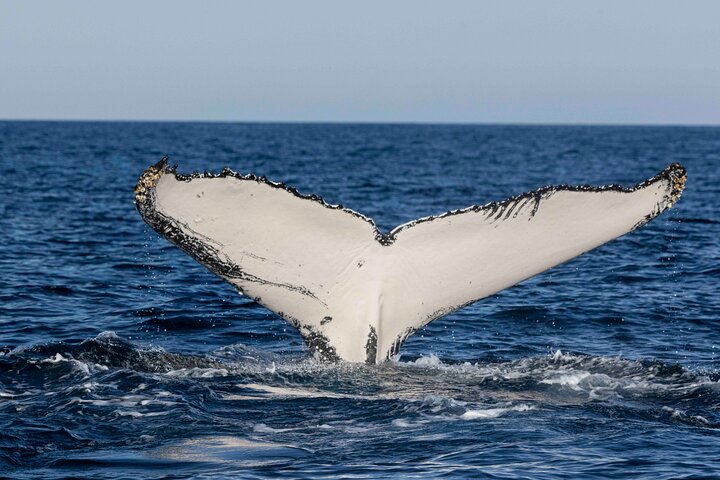What turns a good trip into an unforgettable one? It might be spotting a humpback breach before you or drifting alongside sea turtles through a reef.
Whale watching in NSW delivers these moments along Cabarita’s scenic coastline. Sunrise sightings on the headland and diving adventures at Cook Island or Fingal make this region feel close to nature.
Whale Watching in NSW: Scenic Spots You’ll Remember
As the more astounding months roll in, whale watching becomes a daily highlight along the headlands of Northern NSW. This stretch of coastline is known for being peaceful and picturesque, with clear views and minimal crowds.
These giant visitors tail-slap between June and October, and cruise through warm waters along the shoreline.
Here are the top vantage points worth visiting:
- Cabarita Headland (walking distance) – Easily accessible and wonderfully quiet, this local gem offers uninterrupted views perfect for early whale season.
- Hastings Point Headland (5-minute drive) – With its elevated views and relaxed vibe, this lookout is a popular spot to observe whale migration in peace.
- Fingal Head Lookout (30-minute drive) – Featuring a historic lighthouse and expansive viewing area, this platform is one of the best locations to witness whale migration in Australia.
- Point Danger Lookout, Tweed Heads (35-minute drive) – Equipped with educational signage and a purpose-built whale-watching deck, it’s ideal for first-time whale watchers looking to enjoy whale spotting in Australia at its finest.
- Cape Byron Lighthouse (40-minute drive) – This iconic site combines sweeping ocean views with high elevation, making it a top location for whale watching in New South Wales and a must-visit for nature lovers.
Where to Dive and Snorkel Near Cabarita
Once you’ve experienced the awe of a breaching whale, the next step is to head below the surface. Northern NSW is home to some of the most diverse and accessible diving in the region.
These protected areas showcase everything from green sea turtles to soft coral and tropical fish for those interested in diving.
Consider adding these sites to your itinerary:
Cook Island Marine Reserve
(departing from Tweed Heads – 30–35 minutes away)
Known for its thriving ecosystem, this dive site regularly attracts turtles, rays, and reef species. It’s a top spot for divers of all experience levels and a standout destination for diving in NSW.
Julian Rocks Marine Reserve, Byron Bay
(40-minute drive)
Frequently ranked among Australia’s best dive sites, Julian Rocks is perfect for spotting larger marine species in addition to reef dwellers. It’s an essential part of any list exploring the best of whale watching in Australia and undersea life.
Fingal Beach & Surrounding Rocky Outcrops
(30-minute drive)
Offering shore-accessible snorkelling, this area is popular for casual reef exploration. Clear waters and gentle currents make it a relaxing add-on after a morning of whale watching.
Understanding the Whale Season in NSW
The annual whale migration brings thousands of humpbacks along the Northern Rivers coastline between June and October. This period marks the peak of whale season, with daily sightings along headlands and beaches.
Here’s what to know before you go:
- Best months: June to October, with peak sightings in July and August
- Prime times: Early mornings offer the best conditions with calmer seas, better light, and more surface activity
- Popular spots: Locals gather on lookouts with a hot drink, ready to spot the day’s first breach
- Other species: Keep an eye out for southern right whales, pilot whales, and even dolphins
- Top tip: Coastal walks and beachside trails are perfect for whale spotting in Australia without needing a tour.
Natural Highlights: Why Cabarita is a Hidden Gem
Nestled on the Northern NSW coastline, Cabarita offers a slower pace, vast ocean views, and whale watching that feels personal and uninterrupted.
Unlike busier spots further north, this stretch of coast gives you space to watch, wander, and reconnect with the natural world.
A few standout locations make this area shine:
- Cabarita Headland – Just a short walk from town, this spot is one of the top places for whale watching in New South Wales, thanks to its height, serenity, and location along the migration route.
- Hastings Point Beach – Perfect for quiet beach walks after morning sightings, this area is also close to the elevated headland mentioned earlier—ideal for spotting humpback whale migration in Australia.
- Lookouts – These elevated and coastal platforms are scattered throughout the region, offering accessible, uncrowded spaces where you can pause and soak in the view.
A Holiday to Remember Starts with Nature
Whale watching, particularly along this lesser-known stretch of the coast, delivers grounding and awe-inspiring experiences. You start your day by walking to the headland, catching the morning light on the water.
Later, you’re gliding through calm waters off Fingal or Julian Rocks, watching reef life unfold in real time. These moments stay with you. They give you pause. They remind you what it feels like to connect with nature, without noise or rush.
A perfect trip often comes down to beauty, stillness, and the kind of stories you’ll want to share for years to come. This is where it begins.
Stay Close to the Action: Your Base at The Beach Cabarita
At The Beach Cabarita, you’ll wake each morning just steps from the Cabarita Headland, one of the best places for whale watching. Head out early to spot a breach at sunrise or return from a reef dive in the Cook Islands. Our beachfront location places you right where the sea comes alive.
Here, spacious self-contained apartments offer a quiet, indulgent retreat between adventures. Spend your downtime in one of three inviting pools, unwind in the tropical gardens, or take a leisurely lunch at the on-site restaurant before heading out again. Is relaxation high on your list? We’re happy to help organise in-room massages or local babysitting so you can make the most of every moment.
Start your journey with us.
Image Credit: Whale Watching in Fingal Head
